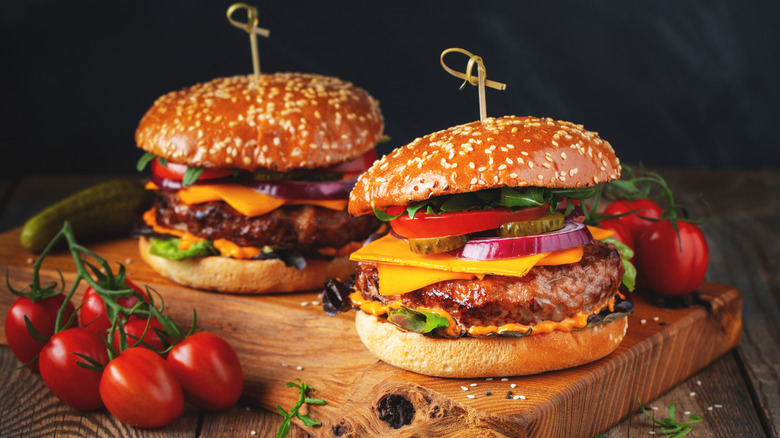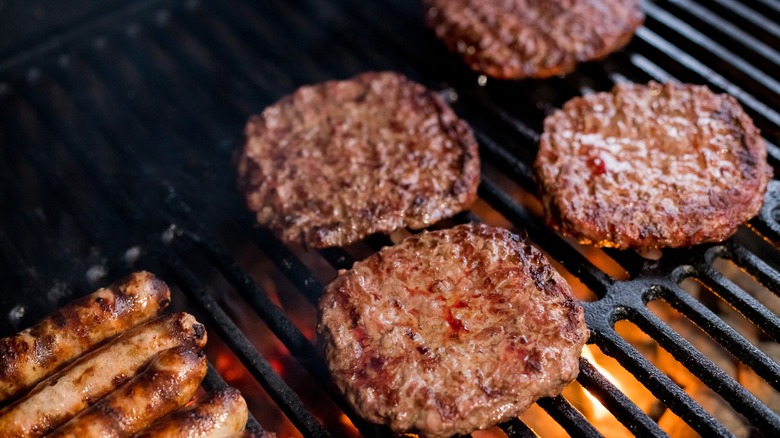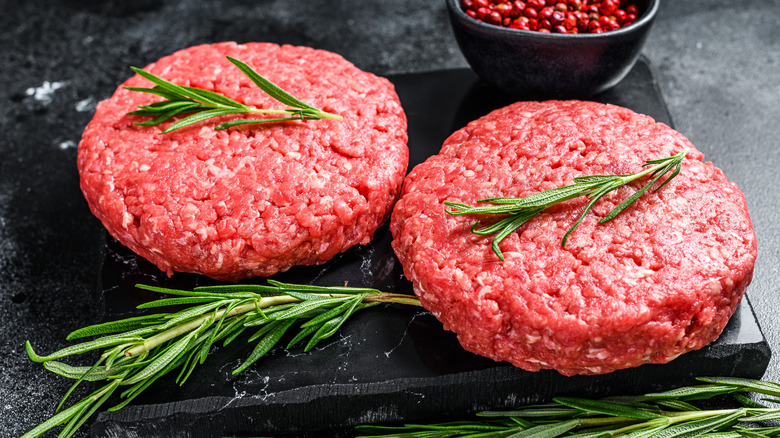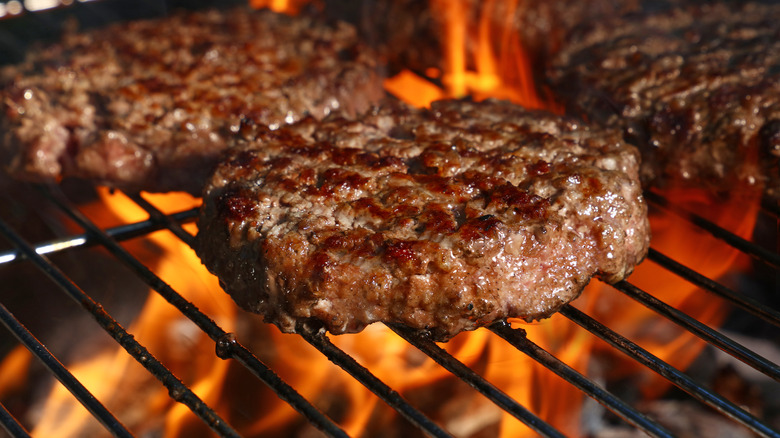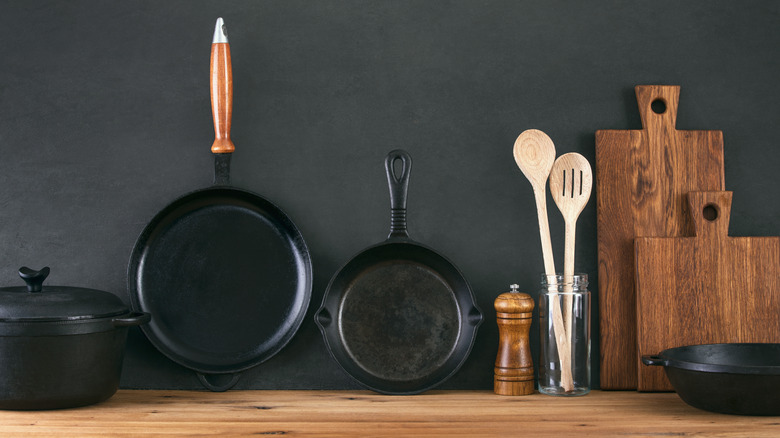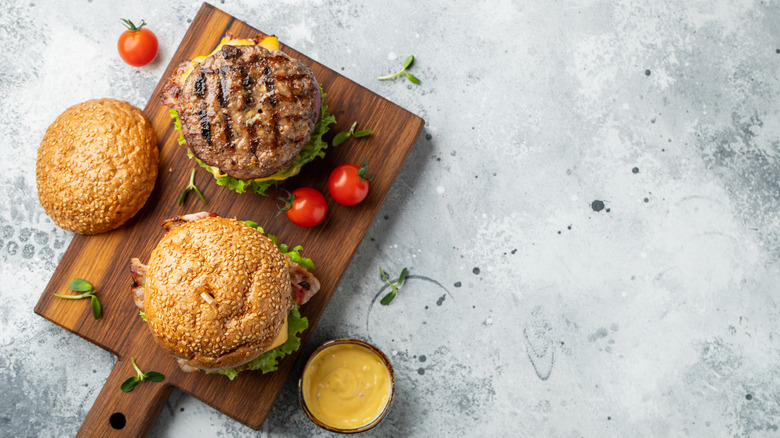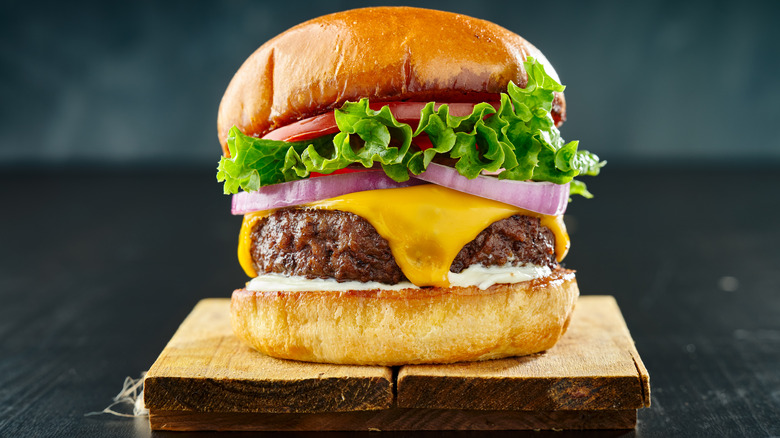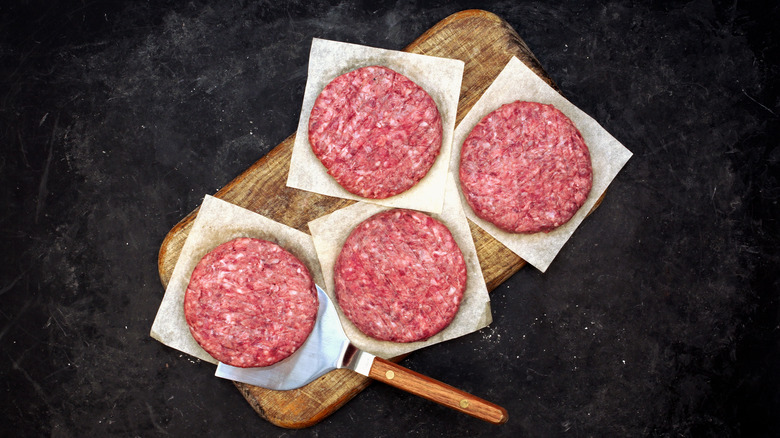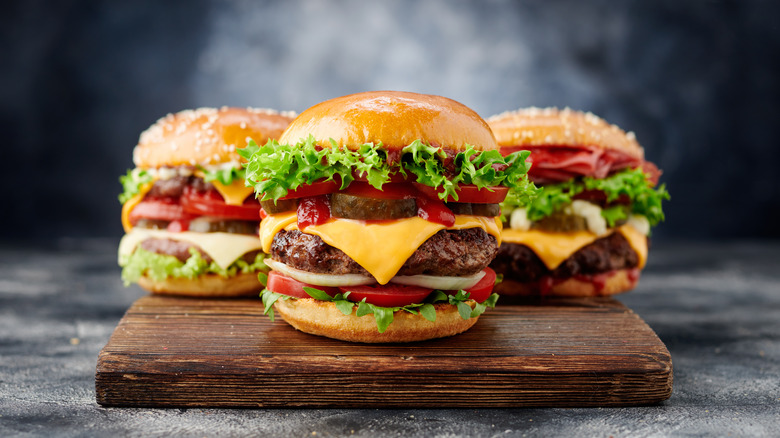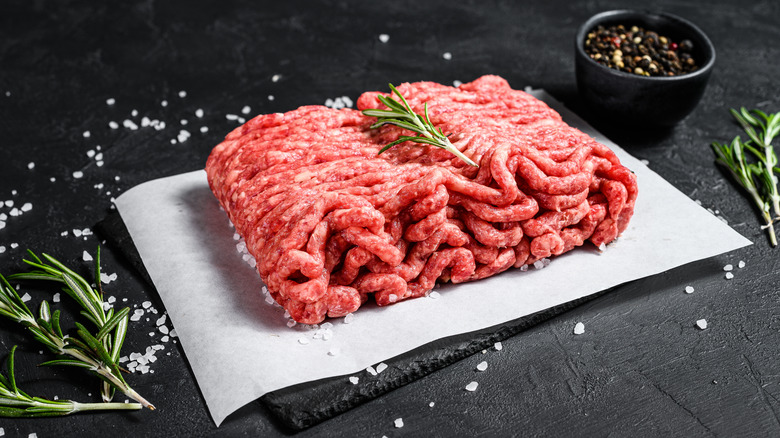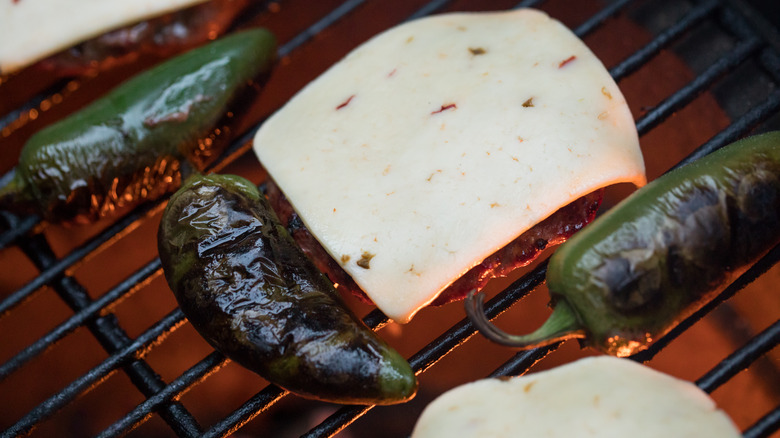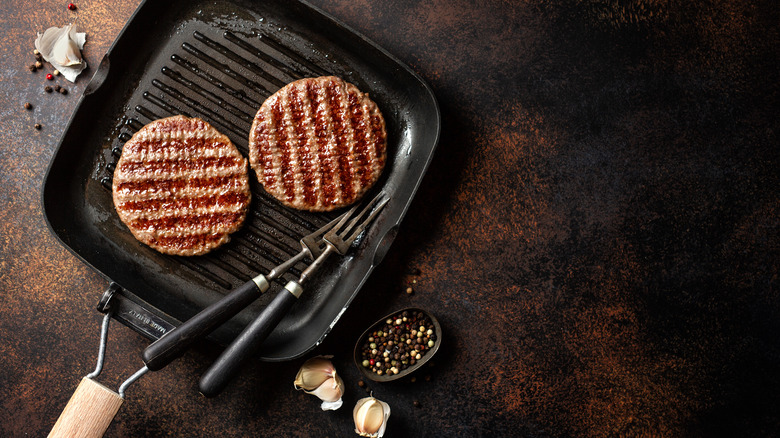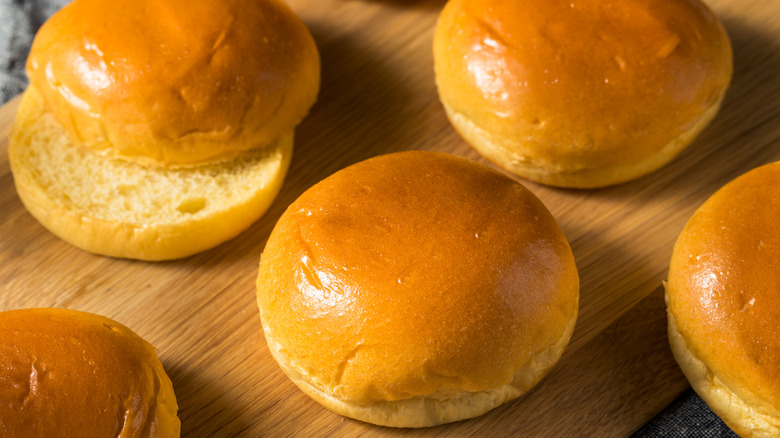Common Mistakes Everyone Makes With Hamburgers
Ah, the burger. The hero of summer, a longtime trusty companion to the grill, and a blank canvas for countless cheese, sauce, and veggie combinations. Hamburgers are staple menu items for many restaurants and one of the main faces of fast food, but cooking at home gives you the reins in burger mastery. And cooking hamburgers requires just that — a master's touch.
Eating a good burger is amazing, but it's tough to forget biting into a bad one. To anyone who's never attempted it, cooking up the right burger seems basic in practice, but there are plenty of ways that preparing this humble sandwich can go wrong. You can ease some of the pressure by opting for frozen, pre-shaped hamburger patties, but you'll sacrifice the opportunity to mix in other ingredients and elevate the taste of your meat.
After honing your burger-making skills, you'll kick yourself for ever being intimidated by a simple patty. From soggy bun woes to misshapen patties to tough, overcooked meat, these are the mistakes you may not realize you're making when attempting the perfect quarter-pounder.
Using frozen or room temperature meat
There are meats that should be room temperature before cooking. Burgers are not one of them. Fat plays a big role in hamburgers, and cold meat is best to allow the fat to melt into the meat while cooking (via Burger Artist). While we understand being impatient to get the barbecue going, frozen patties should thaw in the refrigerator the night before you grill.
This is mostly for keeping your ground beef safe to eat. Hamburger meat that gets too warm too quickly is susceptible to bacteria growth, beef purveyor Schweid and Sons CEO Jamie Schweid told Country Living. The temperature of your meat makes a difference in sustaining the shape of your patties. If the fat in the meat renders too early, your patties' shape may fall apart. "If you want your burger to keep its patty formation, leave it in the fridge until your pan or grill is ready for it," Schweid recommends. Burgers cook from the outside in, and there is more liquid moisture in a room-temp burger, "Which may prolong the searing process resulting in an overdone burger," Schweid says.
What about frozen burgers? According to Recipe Lion, while frozen burgers are great to keep on hand if you get a spontaneous itch to grill or are too pressed on time to form patties by hand, frozen patties will take longer to cook, which could disrupt your burgers' taste and texture, as well as uniform cooking across each patty.
Over-mixed ground beef
It won't shatter if you drop it, but you should still handle your ground beef with care. When flavoring your patties with veggies, liquids, or spices, only mix the beef just enough to incorporate the add-ins. Overdoing it will run the risk of ruining the meat's texture, leaving it too compact and tough (via Martha Stewart).
In order to make the perfect hamburger patties, use your hands to gently mix the beef with your add-ins. Never use an electric mixer or stand mixer to combine your beef and spices, veggies, or sauces. Be sure to wet your hands with cold water before handling the raw meat — this prevents the myosin protein in the beef from further breaking down and forming sticky, dense, overworked patties.
Less is more when handling ground beef. After rolling and shaping your burgers, they can be chilled in the fridge to firm back up and maintain their shapes before hitting the grill.
Didn't preheat the grill
To achieve the coveted perfect hamburger, give your grill time to wake up before slapping the patties on. No matter whether it's charcoal, electric, or gas, every grill needs a good warm-up period before you put it to work, Weber says. It may seem like a mistake with little consequence, but this burger blunder can leave you with a myriad of problems.
Starting your burgers off on cold grates means they will be on the grill for much longer, leading to overcooking and a tough patty as the meat's moisture is dried up over time. And if you're someone who enjoys a crispy, caramelized sear on their grilled meat, a cold grill will steal away any chance of that scrumptious char. You may also find your burgers are sticking to your grill if you don't preheat it, according to Weber. Hot grates will instantly caramelize and sear the meat, so the patties will separate off the grates and flip with ease. Weber recommends preheating the grill for about 15 minutes before loading it up with burgers.
Didn't use cast iron
Plagued by dried-out burger patties? Your cast iron skillet just might be your saving grace. When put on a grill, the ground beef's juices will run out of the patty and down the grates, but putting your burgers on a skillet will allow the meat to simmer in its runoff while cooking. Juicy!
We know what you're thinking: If that's the case, why use a grill at all? By putting your patties on a cast iron skillet directly on your grill's grates, you will get the best of both worlds: the smoky flavor from the grill, and the moist burgers from using a pan (via Chicago Tribune). This will also help you keep a hold on the patty if it starts to fall apart a bit while cooking.
Another benefit of using cast iron is its reputation for a stellar sear. When you fire up the grill, be sure to put the cast iron on at the same time. This metal needs plenty of time to get to temp, but a thoroughly-preheated cast iron skillet will sear your patties beautifully and evenly.
Lean-to-fat ratio is off
Don't shy away from fat in hamburger meat. The marbling in ground beef enriches its flavor and provides juiciness to a cut of meat that is not inherently tender. If your chief complaint is a tough, dried-out burger, you may need a plumper blend of meat. The U.S. Department of Agriculture allows a maximum of 30% fat in hamburger meat, but the lean-to-fat ratios you're most likely to see in stores are 85% lean to 15% fat (the most lean blend, containing the least fat), 80% lean to 20% fat, or 75% lean to 25% fat (the fattiest blend containing the most fat).
So which blend is best for a prime burger? There are a lot of flavors going on in a bit of hamburger, but the meat should be the star of the show, so it's important to pick a ratio that perfectly harmonizes the tastes of the meat and the fat. According to the beef experts at Schweid and Sons, the ideal burger blend is 80% lean to 20% fat. Any ratios higher in fat are likely to result in a greasy burger, while ratios higher in lean meat will dry out faster and lead to a tough patty.
Burgers are too thick or too thin
You may observe some interesting trends if you order enough burgers in different types of restaurants. Some joints lean toward thick, sky-scraping tavern burgers like you may see at your local pub, while others prefer the thinner smash burger, the likes of which are found at popular burger joints like In-N-Out, Shake Shack, and Five Guys (via Chicago Tribune).
It is possible to go too far in either direction, however. The folks over at Char-Broil recommend making patties around ¾ of an inch in thickness. If you go much thicker, the outside of your patties may be overdone while the inside is still too raw. Have you ever ordered a burger at a restaurant and the sandwich that was brought out to you was too tall to even get your jaws around? You don't want to create a final product that is too much to eat once all of your fixings are piled on.
Only ¾ of an inch may not feel like much when you're shaping the patties, but you'll be grateful for the thinner patty while assembling your sandwich — no mandible unhinging necessary. Just don't go too thin — no one appreciates a burger that can't stand up to its bun or toppings.
Didn't dimple your burgers
Dimples are cute on a smiling face and a necessity to the prime hamburger. Cooks Illustrated says that indenting your patties is a necessity when using a grill or a broiler. When grilling, the burgers meet direct heat, which causes the edges of the patty to cook quickly and shrink. The edges cinch up and push the inner part of the patty up and outward.
Press your thumb into the center of each patty on only one side until a distinct indentation forms. This indent will prevent the dreaded curling up of your patties. Place the patties on the grill non-dimpled side down first.
Cooks Illustrated adds that dimpling is not needed when cooking meat on a stovetop skillet. In this method, there is no direct heat surrounding the patty, and instead it only hits one side through the pan. The edges of the burger don't come into contact with direct heat, so its collagen doesn't shrink and cause the burger to puff up.
Patties are too big
Just because you can try to replicate the half-pounder double-decker heart attack on a bun burger from your local sandwich joint doesn't mean you should. Not only is a giant patty more likely to lose its shape on the grill grates, but it will also be either too thick — leading to uneven cooking from the outside to the inside and a burger too tall to eat — or too wide, leading to a patty hanging off the bun.
A standard burger will weigh in at around 4 ounces, also known as the quarter pounder (via Kitchen Seer). If you've shaped your patties to ¾ of an inch thick but they are much wider than your buns, they are likely too big and need an ounce or two shaved off.
What kind of burger you're assembling, however, will determine the weight of your patty. Sliders call for 2 ounces, Kitchen Seer says, while 3 ounces is similar to most fast food burgers. Anything weighing 6 ounces or more is likely a craft burger and will be harder to cook — and harder to finish.
Not experimenting with different beef blends
There's more to a perfect burger than meets the eye, and some of the most memorable hamburgers are composed of more than beef chuck. If it seems like your burgers are technically cooked correctly but lack a wow factor, you can try elevating the flavor by ditching the grocery store tubes of ground beef.
Instead, try adding brisket and short ribs to your chuck blend. This method will give you a heartier, meaty flavor with a mouth-watering ratio of leanness to fat, all without changing the familiar texture of hamburger patties.
Beef blends can be achieved at home with a meat grinder, or through the butcher. We recommend making (or asking for) a blend of 1½ pounds of beef chuck, ½ pound of brisket, and 6 ounces of short ribs. Cut the meats into 1-inch pieces and grind with freshly-ground black pepper and salt to taste. You can then form the meat into patties right away or freeze in bulk for later use.
Not exploring new recipes and ingredients
Everyone loves a burger topped with the standard lettuce, tomato, onion, and pickles, but you know it's time to think outside of the plate when those toppings are getting old. You can put just about anything between two buns, so you're missing out by not exploring all the ways you can jazz up your patty.
If you're interested in merging two beloved cuisines, try out our quesadilla burger recipe. The patty is drizzled in a zinger chipotle-lime mayonnaise sauce, sandwiched between two cheese-loaded tortillas, and piled with fresh pico de gallo and shredded lettuce. This recipe is a great way to spice up your Tuesday night dinners when the tacos just aren't cutting it.
Too shy to stray from the standard American fare? The ranch burger recipe is topped with all of the traditional veggies, but the patties are mixed with ranch dressing seasoning and topped with provolone cheese. The cool taste of ranch and creamy provolone bring a fresh twist with respect for the classic. Unexpected additions like Coca-Cola in your patties may sound bizarre, but will elevate an otherwise same-old-same-old burger.
You don't let your burgers rest
The feeling of sinking your teeth into a hot, juicy burger after feeling starved at a cookout is unmatched. But nothing will make your guests cringe at their plates like a soggy mess of a bun caused by a greasy burger. Maintaining a dry bun and juicy patty may seem impossible, but you can protect the often-saturated bottom bun by making sure your patties are cooked through so less bloody runoff will flood your plate, (via Wonder How To).
However, you don't want to end up with a dry burger, so don't cave to the temptation to press on your patties with a spatula while they're cooking. Letting your patties rest will allow the juices to redistribute across the meat (the juices are forced to the center of the burger during cooking, according to Serious Eats), and the excess fat and moisture will run off the patty.
Wonder How To recommends letting your burgers rest on an elevated rack for just a couple of minutes immediately after grilling. Your bun will be less soggy, and no more molten fat will scorch your mouth after the first bite.
Skimping on your buns
The foundation to your patty, a good bun carries a bang-up burger. While even a slice of sandwich bread will do in a pinch, you'd be surprised at how changing up the grain of your cheeseburger can lift its flavor by a couple of levels. Your bun options are endless — from your standard sesame buns to English muffins to even big pieces of lettuce — but the right one is subjective.
Of our favorites, the first contender is the potato bun. It's a dense, starchy bread made of potato flour rather than wheat flour, (via Bakerly). Its high density affords a sturdier base for your patties and condiments, so you may find it a great choice for the most loaded burgers. Alternatively, you could consider the pretzel bun if you want a hearty bread that's resistant to the sogginess from juice runoff. The pretzel flavor is always an interesting addition to a hamburger, but Bakerly advises that its thickness can be a bit of a double-edged sword: These buns can be difficult to get your teeth through, and your burger guts could fall out the opposite side of the bun while you're trying to gnaw through it.
Buttery, rich, and soft. That's what a brioche bun brings to the burger party. This French version of bread is made with more eggs and butter than other types, according to Bakerly, and is a delightful contrast to a meaty, savory beef patty.
